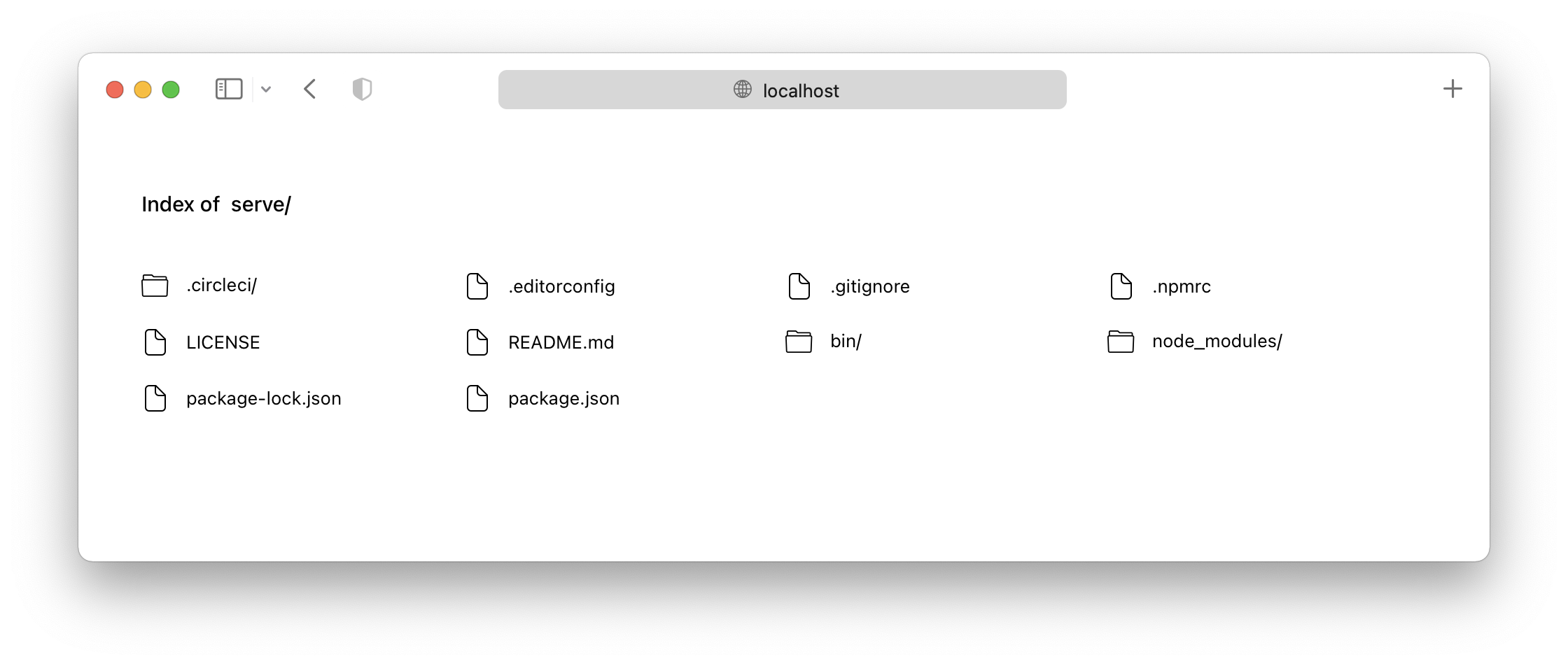| 1 | 
|
| 2 |
|
| 3 | <div align="center">
|
| 4 | <a aria-label="Vercel logo" href="https://vercel.com">
|
| 5 | <img src="https://img.shields.io/badge/made%20by-vercel-%23000000">
|
| 6 | </a>
|
| 7 | <br>
|
| 8 | <a aria-label="Install Size" href="https://packagephobia.com/result?p=serve">
|
| 9 | <img src="https://packagephobia.com/badge?p=serve">
|
| 10 | </a>
|
| 11 | <a aria-label="Stars" href="https://github.com/vercel/serve/stargazers">
|
| 12 | <img src="https://img.shields.io/github/stars/vercel/serve">
|
| 13 | </a>
|
| 14 | <a aria-label="Build Status" href="https://github.com/vercel/serve/actions/workflows/ci.yaml">
|
| 15 | <img src="https://github.com/vercel/serve/actions/workflows/ci.yaml/badge.svg">
|
| 16 | </a>
|
| 17 | </div>
|
| 18 |
|
| 19 | ---
|
| 20 |
|
| 21 | `serve` helps you serve a static site, single page application or just a static file (no matter if on your device or on the local network). It also provides a neat interface for listing the directory's contents:
|
| 22 |
|
| 23 | 
|
| 24 |
|
| 25 | > Once it's time to push your site to production, we recommend using [Vercel](https://vercel.com).
|
| 26 |
|
| 27 | ## Usage
|
| 28 |
|
| 29 | The quickest way to get started is to just run `npx serve` in your project's directory.
|
| 30 |
|
| 31 | If you prefer, you can also install the package globally (you'll need at least [Node LTS](https://github.com/nodejs/Release#release-schedule)):
|
| 32 |
|
| 33 | ```bash
|
| 34 | > npm install --global serve
|
| 35 | ```
|
| 36 |
|
| 37 | Once that's done, you can run this command inside your project's directory...
|
| 38 |
|
| 39 | ```bash
|
| 40 | > serve
|
| 41 | ```
|
| 42 |
|
| 43 | ...or specify which folder you want to serve:
|
| 44 |
|
| 45 | ```bash
|
| 46 | > serve folder-name/
|
| 47 | ```
|
| 48 |
|
| 49 | Finally, run this command to see a list of all available options:
|
| 50 |
|
| 51 | ```bash
|
| 52 | > serve --help
|
| 53 | ```
|
| 54 |
|
| 55 | Now you understand how the package works! :tada:
|
| 56 |
|
| 57 | ## Configuration
|
| 58 |
|
| 59 | To customize `serve`'s behavior, create a `serve.json` file in the public folder and insert any of [these properties](https://github.com/vercel/serve-handler#options).
|
| 60 |
|
| 61 | ## API
|
| 62 |
|
| 63 | The core of `serve` is [serve-handler](https://github.com/vercel/serve-handler), which can be used as middleware in existing HTTP servers:
|
| 64 |
|
| 65 | ```js
|
| 66 | const handler = require('serve-handler');
|
| 67 | const http = require('http');
|
| 68 |
|
| 69 | const server = http.createServer((request, response) => {
|
| 70 | // You pass two more arguments for config and middleware
|
| 71 | // More details here: https://github.com/vercel/serve-handler#options
|
| 72 | return handler(request, response);
|
| 73 | });
|
| 74 |
|
| 75 | server.listen(3000, () => {
|
| 76 | console.log('Running at http://localhost:3000');
|
| 77 | });
|
| 78 | ```
|
| 79 |
|
| 80 | > **Note**
|
| 81 | >
|
| 82 | > You can also replace `http.createServer` with [micro](https://github.com/vercel/micro).
|
| 83 |
|
| 84 | ## Issues and Contributing
|
| 85 |
|
| 86 | If you want a feature to be added, or wish to report a bug, please open an issue [here](https://github.com/vercel/serve/issues/new).
|
| 87 |
|
| 88 | If you wish to contribute to the project, please read the [contributing guide](contributing.md) first.
|
| 89 |
|
| 90 | ## Credits
|
| 91 |
|
| 92 | This project used to be called "list" and "micro-list". But thanks to [TJ Holowaychuk](https://github.com/tj) handing us the new name, it's now called "serve" (which is much more definite).
|
| 93 |
|
| 94 | ## Author
|
| 95 |
|
| 96 | Leo Lamprecht ([@notquiteleo](https://twitter.com/notquiteleo))
|